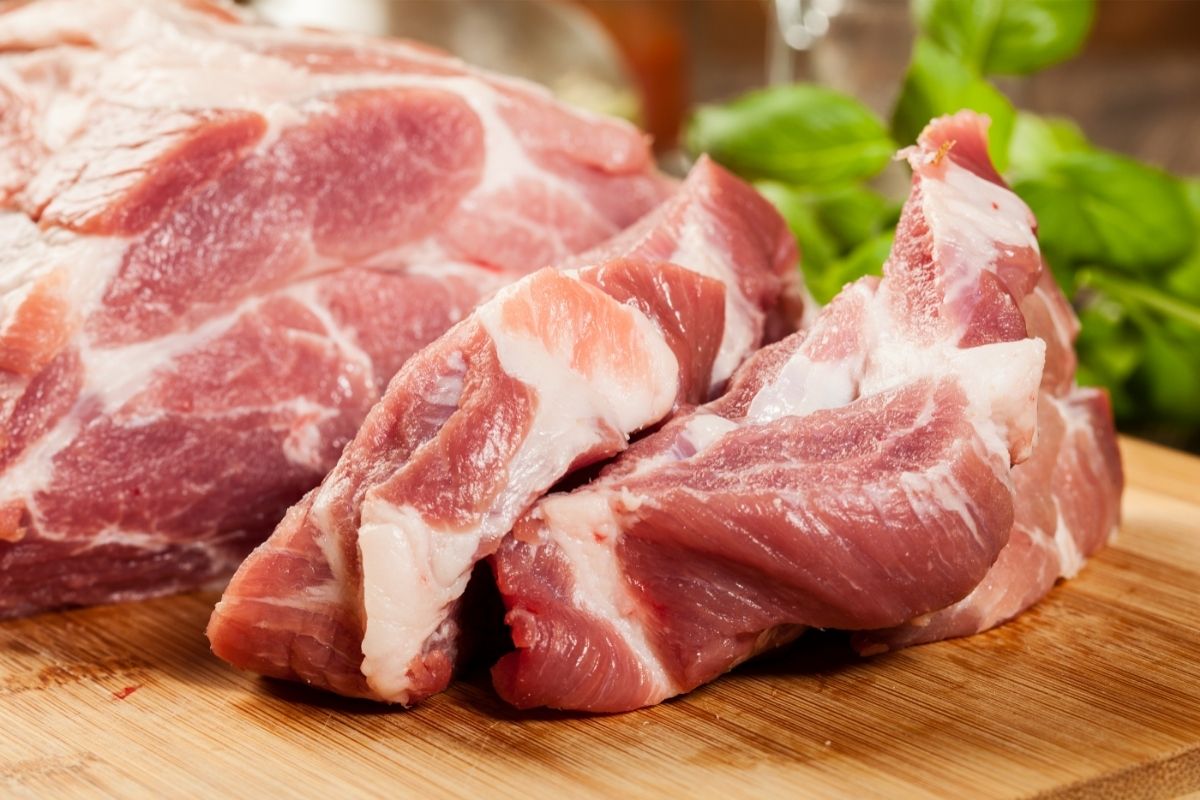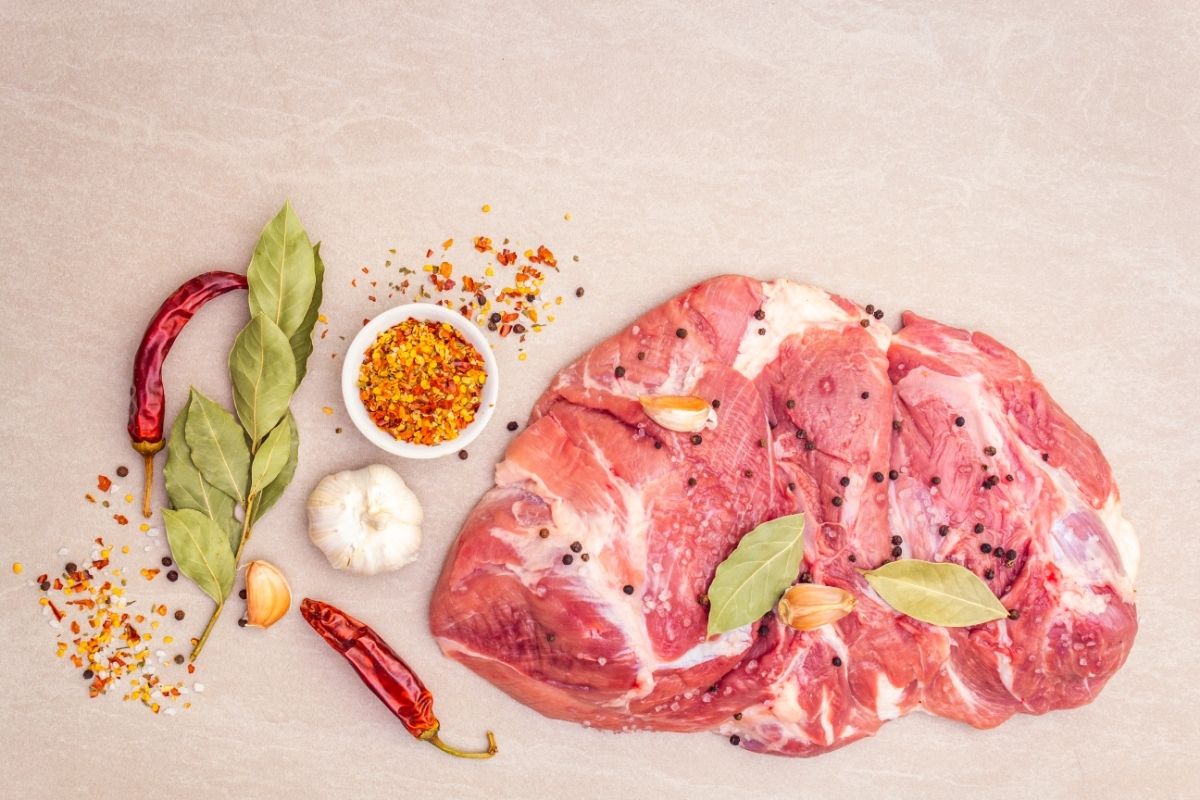Pork shoulder has a higher fat content than other cuts of meat. It’s usually cheaper than buying a whole pork loin.
The main reason for its popularity is that it contains a high amount of collagen, which makes it tender and juicy.

Brining is a very popular process for larger cuts of meat. It can help add flavor and create a better texture and tenderness of the poor.
In this article, we will be discussing whether you should be bringing your pork shoulder.
What Is A Pork Shoulder Brine?
Some cooks like to brine their pork shoulder. By bringing, it is believed that you achieve the best texture for this cut of meat, while also enhancing the flavors as well.
The brine you use can affect the taste of your pork shoulder. Also, sometimes the brain you use can give you a much crisper skin on your pork shoulder.
However, brining is a great way to experiment with a range of seasonings and ingredients. This allows you to create a flavor profile that you like and prefer.
When brining a portion of meat, you allow the moisture in the tissue of the meat to stay where it is.
The cooking process will cause the natural meat juices to be released and evaporated, but the salt in the brine then allows for those juices to be reabsorbed into the meat.
This is what allows your meat to stay so moist and juicy once it’s cooked.
Pork Shoulder: The Facts
Actually, a pork shoulder consists of two different cuts. These are known as the Boston butt or pork butt and the picnic ham/shoulder or just the shoulder.
Typically, the purchase of whole pork shoulder is left for commercial use, but it isn’t unheard of.
Yet it is left for commercial use, as a whole pork shoulder can weigh around 14 to 18 pounds. Which is a lot more meat than most people really need.
The cut known as the shoulder or the picnic ham/shoulder is typically found near the pork butt. This is generally seen near the upper area of the foreleg.
Both cuts contain tough meat, thus it should be cooked long and slow at a very low temperature. This will help to make the meat much more tender.
It is quite easy to tell the difference between the shoulder and butt section of this cut of meat. This is due to the triangular shape of the shoulder.
Normally, you will see pork shoulder sold with its skin still on. This is ideal for anyone who loves a good crispy skin to make crackling with.
When To Brine Your Pork Shoulder For Smoking?
As you will now be aware, that pork shoulder can be a very tough cut of meat.
Therefore, it does need some help, so you can enjoy a much nicer and tender piece of meat than what you start with. Using a good brine can help you achieve this.
However, if you are smoking your pork shoulder, people do worry that the salt may overpower the smoke.
We are here to let you know that this isn’t an issue. In fact, a lot of brine recipes for pork use very little salt. Thus, it won’t affect the smokey flavor that you are trying to achieve.
How Long Should You Be Brining Your Pork Shoulder?
You can actually brine your pork shoulder for a very long time. The longer your pork shoulder is in its brine, the flavor it will absorb.
So you can brine your pork shoulder for between 8 and 24 hours, before cooking.
However, be careful not to over brine your pork shoulder. If you leave your pork shoulder in its brine for over 24 hours, then the meat will begin to suffer.
The salt can cause the protein strands in the mean to begin to break down. This then causes you to have a mush like texture, which isn’t very enjoyable to eat.
Which Is Better: Dry Or Wet Brine?
You do have the choice between a dry and a wet brine to apply to your pork shoulder.
A wet brine uses seasonings and salt that is combined with a lot of liquid. This brine should be able to submerge the entirety of the pork shoulder.
Compared to a dry brine that is made up of mainly salt. You can also add other dry ingredients like herbs.
Yet, a dry brine is mainly just salt that is placed on the meat and into the fridge while it brines.
It is known that using a dry brine is a lot more convenient than a wet brine. As you don’t need to create a saltwater solution.
Also, a dry brine is a lot more convenient if you don’t have much space. As you only need enough space for the meat.
While if you are wet brining then you need enough space for a large stock pot that can withhold the cut of meat and the liquid to submerge the meat.
Alongside that, a lot of people don’t like dealing with wet brine. This is because people don’t feel the feeling of handling the pork shoulder that is not only large, but wet as well.
Making the meat very slippery and messy to handle. Thus, you need to also be careful, as you could spread harmful bacteria around your kitchen if you aren’t careful, due to the raw meat.
Dry Brining Pork Butt Or Shoulder

When dry brining a pork butt or shoulder, you should have a very generous amount of salt.
You could also use other seasonings or sugar as well, this depends on the flavor profile you wish to create.
There is no real rule on how much salt you need to use. However, the aim is to coat the whole surface of the pork butt or shoulder. The larger the cut, the more salt you can apply.
If you are going to smoke your pork, and it still has its skin on. Then if you mix baking powder with the salt, then this will help you create a really crispy skin.
The ratio of baking powder to salt is 1:3.
How Long Can I Dry Brine Pork Butt?
When it comes to dry brining, you can leave it far longer than if you were wet brining.
However, the minimum you should dry brining is around 12 hours, however, you can leave it in your refrigerator for around 3 days.
With a dry brine that won’t waterlog your pork the same way a wet brine would. Instead, the wet dry needs this extra time to really make its way into the meat.
However, with any brine wet or dry, if you leave your brine on for too long this will affect the pork.
In this case, if you leave your dry brine on for longer than three days then the flavor will start to taste like a cured ham, and then the meat could then begin to spoil as well.
As a result, when dry brining, aim for 24 to 48 hours for your pork butt or shoulder.
Do You Dry Brine Uncovered Or Covered?
We would recommend that when you’re dry brining, you should leave the pork shoulder uncovered. This is really important if the skin has been left on the pork shoulder.
Also, the air that is in your fridge, will pull any extra moisture from the meat to the surface. This will then give you a much crisper skin once the pork has been cooked.
Is Brining Pork Shoulder A Good Idea?
A lot of people really believe that dry brining is worth the effort due to the results. However, sometimes it depends on if you have enough time to do it before cooking your pork shoulder.
If you have between 8 and 24 hours then maybe consider a wet brine if you do want to brine or forget the burning process altogether.
Otherwise, the brine won’t have enough time to do its work to give you the best results.
What Type Of Salt Should You Use To Brine?
Typically, kosher salt is the best type of salt that should be used when it comes to brining. It is a great option for wet and dry brining.
You may be tempted to use table salt, and you can if you want to.
However, if you do use this substitute, then you should reduce the amount of salt you are using by 25%.
Hence, if your recipes asks you to use 1 cup of kosher salt, then you should only use 3/4 of a cup of table salt.
Brining Pork Shoulder With Curing Salt
Curing salt is also referred to as Prague powder. This is a type of salt that is often used to preserve meat. Sometimes it may be known as pink curing salt as well.
We would advise that you never try to brine your pork shoulder with curing salt. Unless you want to create ham and not pulled pork.
Curing salt does what it says on the tin, it is for curing and can’t be used as a substitute for table or kosher salt for brining.
Recipe: Pork Shoulder Wet Brining

This recipe is ideal when you have a pork shoulder which weighs between 6 and 8 pounds.
However, if your pork shoulder is bigger or smaller than you should adjust the quantities to suit your meat weight.
Ingredients
- 8 cups water
- 2 cups apple juice or cider
- ¾ cup kosher salt
- ½ cup brown sugar
- 1 tbsp fresh rosemary
- 2 tbsp black peppercorns
- 3 bay leaves
- ½ onion
- 6 crushed garlic cloves
- 1 tbsp paprika
- 1 tsp ground cumin
- ¼ tsp cayenne pepper
- 1 tsp fresh thyme
Directions
Step 1
Get a large stock pot and bring cider, water, or apple juice to a simmer.
Step 2
Dissolve sugar and salt in this liquid.
Step 3
Add the other ingredients and let the mixture cool down by leaving it uncovered in the fridge.
Step 4
Once the brine is cold, add the brine to a container that will contain the brine and pork shoulder comfortably.
Step 5
Place your pork shoulder into the brine. Then place in the fridge overnight.
Step 6
After 12 hours, your pork shoulder is ready to be cooked your preferred way.
Method: Dry Brining Pork Shoulder
Step 1
Mix together 1 part baking powder to 3 parts salt.
Step 2
Pat and dry your pork shoulder with paper towels.
Step 3
Rub the salt mixture over the meat and place in the fridge for up to 48 hours.
Step 4
After 24 hours, your meat is ready and there is no need to rinse any leftover salt. Now cook your pork your preferred way.
Conclusion
Brining can improve the texture and flavor of your pork shoulder. A wet or dry brine can be really beneficial.
Hopefully now you know whether you should be bringing your pork shoulder and the effect it has.
Thank you for reading!
- The 9 Best BBQ Grills for Smoking Brisket - December 29, 2022
- 6 Mouth Watering Grilled Shrimp Recipes - September 16, 2022
- 6 Delicious Grilled Desserts - September 16, 2022

